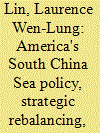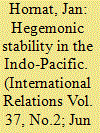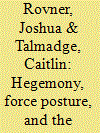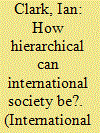| Srl | Item |
| 1 |
ID:
126134


|
|
|
|
|
| Publication |
2013.
|
| Summary/Abstract |
The US South China Sea policy is designed to deny power transition in the Asia-Pacific. Strategic rebalancing has become America's Asia-Pacific Strategy for reassuring hegemonic stability and supporting its South China Sea policy. Practically, strategic rebalancing depends heavily upon naval diplomacy. As a result of us naval diplomacy, the DOC (Declaration on the Conduct of Parties in the South China Sea)-symbolized "ASEAN+China" mechanism is being eroded by the looming US-dominated neo-realistic framework, an indication that Washington's strategic rebalancing has secured preliminary success. Yet, the creditability of US naval diplomacy in the South China Sea ultimately rests upon the progress of the Navy's maritime strategy in the Asia-Pacific. Michael Mullen's idea of "landward push" of sea control resides at the core of the 2007 Maritime Strategy, of which the core operational mechanism is the Navy Expeditionary Combat Command (NECC). NECC is key to the AirSea Battle concept and naval diplomacy. The 2012 and 2013 Balikatan exercises have showcased the utilities of NECC and provided much edification: with the use of versatile naval diplomacy, the US Navy has insinuated Mullen's idea into the South China Sea, advanced AirSea Battle, facilitated strategic rebalancing, and reassured its South China Sea policy. If China fails to fully comprehend the progress of America's maritime strategy, it may end up wrestling with a far superior balancing coalition that is being created by the US.
|
|
|
|
|
|
|
|
|
|
|
|
|
|
|
|
| 2 |
ID:
191960


|
|
|
|
|
| Summary/Abstract |
The United States has improved relations with no other country during the Trump administration as much as it advanced its relationship with India. US-India relations have arguably marked their historical high points since Trump entered office and India seems to be overcoming its suspicion of closer cooperation with the US. Given these developments, this article aims to theorize the relationship through the hegemonic stability theory and explain US strategy toward India. We first demonstrate why India is accepting the hegemonic standing of the US in the Indo-Pacific and then – since balance of power politics are still a staple of policymakers’ approach to stability in the Indo-Pacific – we introduce the notion of induced balancing to show what approach the United States has adopted to empower India to expand its balancing capacity vis-à-vis China. The last section of the article empirically maps the various incentives that Washington offers to New Delhi in order to situate it in the desired position of a proxy China-balancer.
|
|
|
|
|
|
|
|
|
|
|
|
|
|
|
|
| 3 |
ID:
134007


|
|
|
|
|
| Publication |
2014.
|
| Summary/Abstract |
International relations theories emphasize the stabilizing role hegemons play in world politics. But little scholarship has examined the link connecting hegemony to its potentially positive returns in the security realm: force posture. We correct this deficit by developing and testing an argument about the consequences of different hegemonic force postures under varying threat conditions. We present a typology of force posture options and probe their effects through over-time analysis of how major powers have worked to provide one particularly important public good since 1945: access to Persian Gulf oil. Drawing on field work, we also explore the implications of our framework for current and future US force posture in the region. We conclude that hegemonic stability is a very real phenomenon in the Gulf, but it does not require the massive forward deployment of US forces that has characterized the past twenty years of US presence there.
|
|
|
|
|
|
|
|
|
|
|
|
|
|
|
|
| 4 |
ID:
092041


|
|
|
|
|
| Publication |
2009.
|
| Summary/Abstract |
Waltzian analysis proceeds from the distinction between the ordering principles of anarchy and hierarchy. This raises the large question whether the introduction of pockets of 'authority' would represent a fundamental challenge to an anarchical international society. The article investigates this theme by exploring a putative institution of hegemony. It begins with a distinction between primacy and hegemony, and develops the idea of hegemony as a potentially legitimate practice of international society. Since most political systems are 'mixed', it then concludes that adoption of a hierarchical principle of hegemony is no more contradictory for international society than is its development of other such institutions. In common with much recent scholarship, it agrees that international society can function as a form of 'hierarchy under anarchy', within which hegemony could play its part. The article finally demonstrates what is distinctive to hegemonic behaviour, and suggests that practices such as soft balancing do not represent any form of balancing at all, but are better understood as attempts to institutionalise hegemony.
|
|
|
|
|
|
|
|
|
|
|
|
|
|
|
|